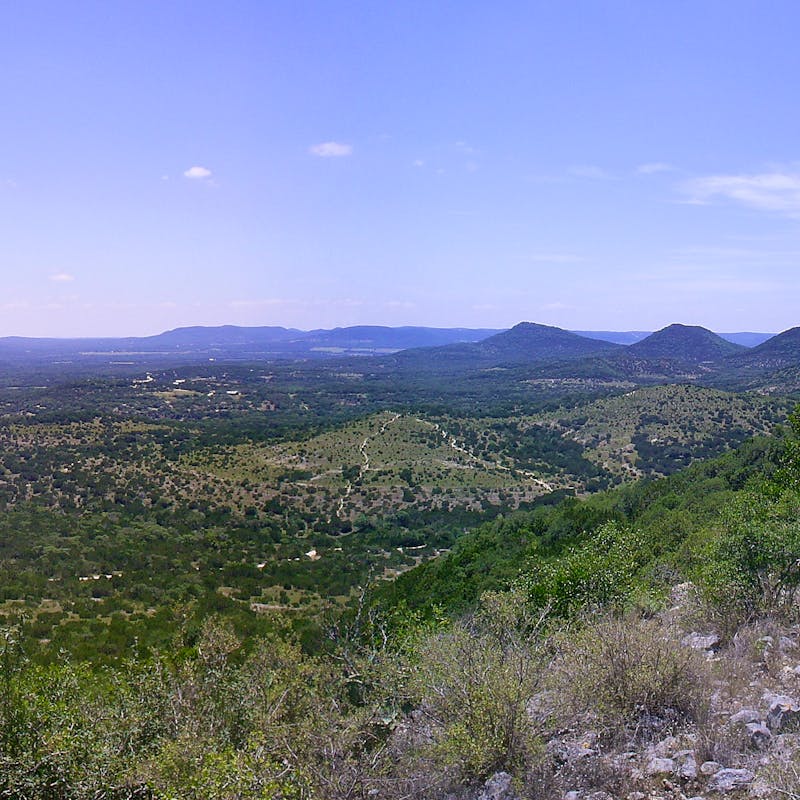Get to Know the Golden-cheeked Warbler and its Important Habitat
Celebrated for their ability to soar into the sky and travel great distances, birds are often seen as symbols of freedom. The golden-cheeked warbler is no exception. The small songbird aviates to mountainous pine-oak forest of southern México and Central America before migrating back each spring to nest in Ashe juniper and oak woodlands in the rolling hills of Central Texas, charmingly nicknamed the Texas Hill Country.
Golden-cheeked warblers are known for two of the males’ songs. The first is sung as they arrive to their nesting grounds around mid-March to scope out their territory. The second is sung as females arrive and it signifies the start of courting and mating. Golden-cheeked warblers breed nowhere else in the world, making all offspring native Texans by birth. Female golden-cheeked warblers require specialized habitat, found only in the region, to build their nest. They strip bark off mature Ashe juniper trees, like thread off frayed rope, and gather strands to weave the foundation of their nest.
While this distinctive habitat makes the golden-cheek warbler special to the region, it also leaves the species highly vulnerable to habitat fragmentation and degradation. In fact, in 2022, Defenders of Wildlife found suitable habitat for the warbler had declined over the span of the last three decades due to habitat conversion.
A Seesawing Debate to Downlist
Golden-cheeked warblers were listed as endangered under the Endangered Species Act in 1990, but recent opposition efforts have raised concerns about the species’ future. Stemming from a case that was originally filed in 2015 when the Texas Public Policy Foundation petitioned the U.S. Fish and Wildlife Service to have the warbler removed on behalf of the Texas General Land Office, which owns land in the warbler’s habitat. In 2016, the FWS reviewed the petition and determined it did not present enough new information to warrant delisting. Disagreeing with the outcome, in 2017 Texas General Land Office sued FWS. This continued back and forth for several years until September 2024, when a U.S. District Judge ruled in favor of the Texas General Land Office, determining FWS had applied inappropriately heightened standard in denying the delisting petition. In early 2025, FWS formally withdrew their appeal of the ruling, effectively upholding the decision to reconsider the delisting petition.
Soon after the ruling, FWS released the five-year review for the golden-cheeked warbler and recommended downlisting the species from endangered to threatened. The recommendation was based on “improved understanding” of the species’ status and habitat, and ongoing conservation efforts. While FWS acknowledged the continuing and growing threats, the future of the warbler's protection status remains uncertain at this time.
Why is the Golden-cheeked Warbler Endangered?
Golden-cheeked warblers were originally listed under the ESA as an emergency action due to “ongoing and imminent habitat destruction,” warranting consideration for long-term federal protection. If these beloved songbirds are downlisted, they may lose some critical protections needed to recover and downlisting undermines the severity of ongoing threats.
One major threat is Texas’ unprecedented human population growth, which is resulting in rapid, unplanned development taking place in suitable golden-cheeked warbler habitat. Development must be balanced with planned conservation measures.
Protections for warbler habitat have already come under fire by some Texas officials. In 2023, Texas House Bill 2239 aimed to prevent municipalities from regulating the removal of Ashe juniper trees. The bill was placed on the Texas Senate’s intent calendar, but luckily did not progress before the end of the legislative session. Now — a new, but similar bill — Senate Bill 1927 once again threatens the protection of this critical habitat.
Protecting Golden-cheeked Warblers and Ashe Juniper Trees
A key to golden-cheek warblers’ nesting habitat is the Ashe juniper tree. These trees have had a long, complex history with people in Central Texas. At one time, Texans believed the tree was an invasive species, sapping scarce water from the soil, and there were efforts to eradicate the tree. With outreach and education, landowners learned Ashe juniper plays a critical role in carbon storage and recharge for the aquifers where ground water is stored.
Today, Defenders works to dispel the myths around these trees. Whether it’s the golden-cheeked warbler or the Ashe juniper, these native plants and animals are worth protecting. The entire Texas Hill Country ecosystem is intricately connected. Removing these species would have severe consequences for the region, and weakening protections now will inevitably lead to a decline in these beloved warblers.














Follow Defenders of Wildlife
facebook bluesky twitter instagram youtube tiktok threads linkedin